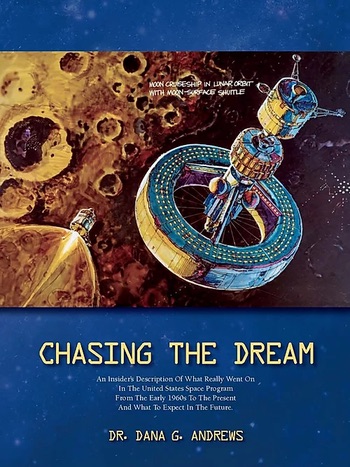 |
by Jeff Foust
Monday, June 15, 2020
Chasing the Dream
by Dana Andrews
Classic Day Publishing, 2020
paperback, 350 pp., illus.
ISBN 978-1-59849-281-1
US$28.95
The history of spaceflight is littered with concepts that never, literally or figuratively, got off the ground. The recent NASA book After LM described dozens of designs for lunar landers proposed after the Apollo program, up through the cancellation of the Constellation program a decade ago, none of which got even to the hardware production phase of development (see “Review: After LM”, The Space Review, June 8, 2020). The same is true, of course, for many other proposed launch vehicles and spacecraft.
“Stopping a successful development program before useful hardware can be delivered has become a very common trait of the U.S. space program,” laments Dana Andrews in his new book, Chasing the Dream. Andrews worked at Boeing for 33 years on a wide range of space projects, then a decade at Andrews Space & Technology, with some teaching of space system design at the University of Washington as well. He reflects on what has gone wrong in spaceflight development, particularly in programs he was involved with during his career, and offers his vision of how to expand humanity into the solar system and beyond.
| “Stopping a successful development program before useful hardware can be delivered has become a very common trait of the U.S. space program,” says Andrews. |
The first part of the book looks at what could have been, notably in the development of reusable vehicles. Throughout the early decades of the Space Age there were many projects in the US looking at spaceplanes in particular. Some were well known, like Dyna-Soar, but many others less so, like the Have Region and Copper Canyon efforts in the 1980s. They are overshadowed by the failure of projects like the National Aerospace Plane and X-33, and the inability of the shuttle to match expectations. However, Andrews believes many of these programs could have advanced the state of the art of reusable launch systems had then been continued, hence the lament quoted above. For example, he believes that had Dyna-Soar flown, it could have demonstrated thermal protection and structure technologies that could have later been incorporated into the shuttle, changing its design into one that “would have led to low cost access to LEO in the early 1980s and significantly changed our space program.”
He is more optimistic about more recent efforts in the private sector, including SpaceX’s Falcon 9 and Heavy and its Starship/Super Heavy under development, as well as Blue Origin’s New Glenn. After watching the first Falcon Heavy launch, he said, “I knew it marked a sea change in the US Space Program, wherein from now on, businesses will be leading the space program, and the focus will shift to space entrepreneurs.” That is arguably necessary since neither NASA nor the Defense Department are now investing in reusable launch technologies to any significant degree.
The second half of the book shifts from what could have been to what could be. Andrews offers a vision for lunar and asteroid mining (based on studies performed by his students) as well as deep space propulsion and even, at the end, interstellar travel. Essential technologies for enabling that, he says, are nuclear power and propulsion; without them, “there will be no spacefaring civilization.” (NASA would seem to agree, based on renewed investments in projects like the Kilopower surface reactor and nuclear thermal propulsion.) Andrews, though, is even more optimistic about fusion; while acknowledging it is a “long shot,” he believes it would alter human spaceflight and space settlement if fusion reactors became a reality.
Those latter chapters offer an optimistic future for spaceflight. But a reader can’t help but think back to the earlier chapters, and all the promising projects that never got going. What’s different this time? Perhaps it’s the greater role of entrepreneurs, yet companies can make decisions as bad as government agencies. With books like this, though, here’s always hope that the next generation will learn from the mistakes of the previous one.
Note: we are temporarily moderating all comments submitted to deal with a surge in spam.
"Review" - Google News
June 16, 2020 at 06:01AM
https://ift.tt/2MY9UBa
Review: Chasing the Dream - The Space Review
"Review" - Google News
https://ift.tt/2YqLwiz
https://ift.tt/3c9nRHD
Bagikan Berita Ini















0 Response to "Review: Chasing the Dream - The Space Review"
Post a Comment